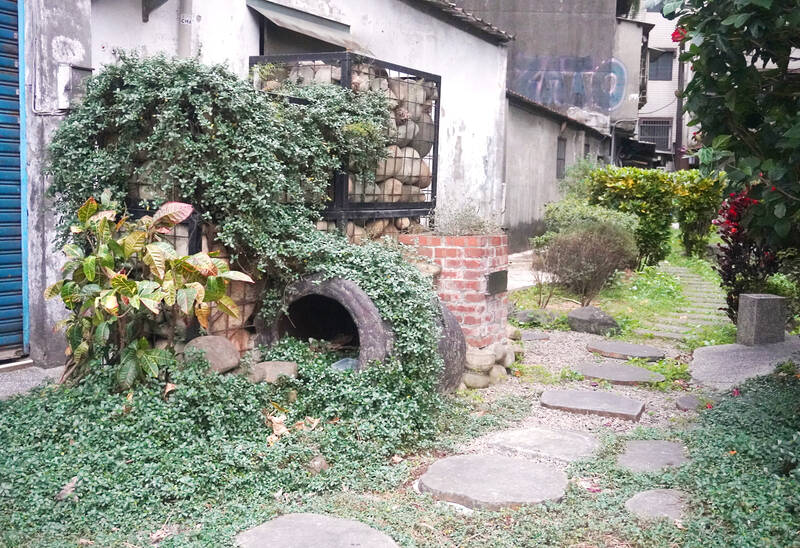Did you know that amid the hustle and bustle of Taipei’s Daan District, you can get a glimpse into the city’s historic irrigation system and appreciate the variety of aquatic life in its vicinity? Although much of the Liugong Canal瑠公圳) was covered as Taiwan transitioned away from being an agricultural society, some segments were preserved and reconstructed on and around National Taiwan University’s (NTU) campus. These offer us a window into Taiwan’s past and the ways in which this land has nurtured generations.
Liugong Pool (瑠公池)
The Liugong Canal once meandered through what is now the NTU campus. As part of its reconstruction project, an artificial pool was created adjacent to Zhoushan Road has since become a thriving habitat for plants and wildlife. In this rare opportunity to connect with nature in an urban setting if you look closely, you might spot kingfishers flitting about, nightherons perched in bald cypress trees, or red-eared turtles basking on rocks between the reeds.

Photo: Bookman 圖片 : Bookman
Liugongzun Memorial Stele (瑠公圳原址碑)
A memorial stele was erected alongside Xinsheng S. Road in commemoration of the original Liugong Canal. However, later research revealed that this site is actually the former location of the Wulixue Canal (霧裡薛圳), sparking debate on the history of Taipei’s irrigation system.
During the Qing era, Chinese immigrants arrived in Taiwan to cultivate farmland, but their progress was hindered by ack of water. Guo Xiliu (郭錫瑠), one of these immigrants, worked tirelessly to secure a water source by constructing a canal, which was later named Liugong Canal in his honor. Despite numerous challenges, he succeeded in channeling water from the Xindian River to central Taipei, ultimately irrigating over 2,000 hectares of farmland.
Xun-Ji and Wulixue Canal Reconstruction Area (洵跡、霧裡薛圳景觀區)
On the west side of Xinsheng South Road, you’ll find two reconstructed sites dedicated to the Wulixue Canal. The Xun-Ji heritage site displays artifacts used in early canal construction, including gabions that fortified shorelines and modified ceramic water urns functioning as primitive concrete conduits.
These exhibits showcase the ingenuity of earlier generations, who overcame hardships with limited resources. In the Wulixue Canal Reconstruction Area, a small canal winds through the Wenzhou Street neighborhood.
The Wulixue Canal flowed through the Guting and Wanhua areas of Taipei and converged with the Liugong Canal in Daan District. During the Japanese colonial period, they were consolidated into the Liugongzun Irrigation System, which sparked controversy about their respective origins. Come and drink in the essence of the Liugong Canal. This restored area not only adds freshness to the city landscape, but also reminds us of the resilience and resourcefulness of past inhabitants, and how nature connects us throughout history.
(English drafted by Lorraine McShea、Kyle Rice、王裕忠、彭心玗 / Revised by Ann-Marie Hadzima & Jerome Su)
瑠公池(台大生態池)
台北曾經是半鹹水湖及沼澤溼地,所以台大校園至今仍可看到許多水濱植物;諸如水柳Warburg Willow、水黃皮Pongame Oiltree、穗花棋盤腳Powder-puff Tree、欖仁樹Indian Almond等。瑠公池(台大生態池),位於舟山路台大生命科學館左方的農場旁,是臺大瑠公圳復原計畫的第一期工程,於2003年11月完成,並栽植數十種水生植物於水源池中及周遭,水源主要來自隔壁地下水層較高的生科館及臺大農場的地下水井。
公圳(ㄗㄨㄣˋ)
*(以下瑠公圳之介紹係根據網路資料濃縮整理)1736年(乾隆元年)郭錫瑠先生從彰化北上,在現台北松山中崙(興雅庄)一帶開墾。由於當時附近柴頭埤(現信義區靠山邊一帶)淤積,無法灌溉大部份的農田。郭錫瑠眼看大片土地因缺水無法種水稻,覺得非常可惜,便決心尋找新水源。他到附近沿溪探勘,發現新店溪上游青潭附近水源豐沛,河床又高,認為只要沿新店溪畔開鑿水圳,經大坪林、景美等地區,就可以解決台北盆地的灌溉問題。
但要順利將水引入興雅庄內,最大的困難就在於如何將圳水引過90多公尺寬的景美(霧裡薛)溪。
郭錫瑠設計一種木製引水槽,架在溪上,引圳水過溪,這種引水槽稱為「木梘」(景美的台語叫「梘尾」,就是木梘的那一頭)。自從有了木梘之後,民眾就走木梘來代替坐船渡河,因此沒幾年,木梘就損毀無法使用。於是郭錫瑠想辦法解決,他訂購大批水缸,將水缸去底接成管線,引圳水過景美溪,才恢復供水。瑠公圳灌溉的農田從大坪林、景美,直到台北市地區,將近兩千多頃。瑠公圳的大安支線一部分經過臺大農場、舟山路、小椰林道及醉月湖。
★ 註:圳 ㄗㄨㄣ ˋ,指灌溉用的水渠。如:「瑠公圳」、「嘉南大圳」;圳 ㄓㄣ ˋ,指田野間的水溝。如:「深圳」。
引起爭議的新生南路三段 瑠公圳原址碑
在新生南路三段台大校門附近,有一「瑠公圳遺原址」石碑,記載郭錫瑠開拓圳道歷史。新生南路在日治初期有一段人工挖掘的堀川,沿新生南路經霧裡薛圳支圳,到新生北路大排水系統,但與瑠公圳有一些距離。
日治時代將水圳管理由民營改為公營,名稱也合併為「瑠公水利組合」,因此後人一碰到台北圳道,都叫瑠公圳。
台灣師範大學地理系洪致文教授指出,目前台大側門立的「瑠公圳原址」碑,比對古地圖應為清朝「霧裡薛圳」舊址,而非「瑠公圳」。
霧裡薛圳遺址(1907年後為?公圳第二幹線)
霧裡圳開發比瑠公圳更早(約1735年),取景美溪水,穿越景興路,景後街到景美國中,公館蟾蜍山,在1735年到1908年之間,霧裡圳與瑠公圳並存。瑠公圳在羅斯福路四段119巷向東走,霧裡薛圳是向北走,灌溉古亭、艋舺、大同區一帶。(1908 年以後稱瑠公圳西幹線) 霧裡薛圳在羅斯福路四段12 巷附近,經羅斯福路三段,到302號附近穿越羅斯福路,流向新生南路三段的溫州街。
洵跡(霧裡薛圳遺址)
在新生南路三段58號的一處景觀區,取名洵跡。主要係呈現霧裡薛圳、瑠公圳在公館、台大附近昔日灌溉系統的足跡,展示古代生態工法維護圳道的石籠。圳道涵洞所用的水缸,如同現代水泥管。
A. 園中植物:朱槿Hibiscus、藍星花Shaggy Dwarf Morningglory、金英花Golden Thryallis、桔梗蘭 Common Dianella、天門冬 Chinese Asparagus。
B. 周遭自生植物:虎葛/烏歛莓/五爪龍Japanese Cayratia Herb、霧水葛Pouzolzia、三角葉西番蓮Corkystem Passionflower、五蕊油柑Mascarene Island Leaf-flower、瑪瑙Twoleaf Nightshade、珊瑚珠Pigeonberry/Rougeplant。
霧裡薛圳 -- 九汴頭
汴頭是指圳溝分水用的閘門,九汴頭的「九」是指好多個,不一定是九個,就像九層塔不一定有九層花序,九孔不一定是九個孔。
在新生南路三段54巷底,霧裡薛圳在此分為幾條支線。東線穿越台大體育館,灌溉復興南路線;中線為主線,向北通向中山區;西線沿羅斯福路通到艋舺。
霧裡薛圳景觀區(大學里)
在九汴頭後方,溫州街49巷內,有一處霧裡薛圳景觀復原區,圳水清澈,水中不少游魚及巴西龜。植物有柳樹Weeping Willow、桑Mulberry、文珠蘭Poison Bulb、桃金孃Myrtle、姑婆芋Giant Elephant’s Ear、流蘇Chinese Fringe Tree、構樹Paper Mulberry、蔓馬櫻丹 Climbing Lantana、番石榴 Guava 等。
周遭還有麵包樹Breadfruit、龍眼Longan、木瓜Papaya、福木Fukugi Tree、楊梅Chinese Bayberry、楓香Sweet Gum等。
文章由書林出版公司提供:
www.bookman.com.tw
蘇正隆 — 台灣翻譯學學會前理事長、師大翻譯研究所兼任副教授; 編著《走讀自然.花言樹語》,《英語的對與錯》,《世紀病毒:必讀防疫英文知識與詞彙》...等。國家教育研究院中英雙語詞彙審議委員;研究領域為翻譯、術語及詞典編譯,從事植物與人文導覽數十年,亦曾應邀遠赴國外大學做植物人文導覽。

Computex, Asia’s biggest electronics conference, kicked off Monday in Taipei, and as in years past drew industry chieftains from Nvidia Corp.’s Jensen Huang and Qualcomm Inc.’s Cristiano Amon to Young Liu of Foxconn, which makes the bulk of the world’s iPhones and Nvidia servers. But while last year’s event was a celebration of the post-ChatGPT AI boom, executives this time are likely grappling with the uncertainty of the Trump administration’s effort to reshape the global trade order — disrupting a decades-old model for tech manufacturing. This year’s exhibition will of course feature the hardware required to bring artificial intelligence to life.

For many people, allergies are an all-too-familiar annoyance. The constant sneezing, itching, and watery eyes are just a few clear signs of allergies, which is a surprisingly common condition affecting millions worldwide. But what exactly triggers these reactions, and how can we cope with them? Allergies arise from a misunderstanding between our immune system and seemingly harmless substances. Under normal circumstances, the immune system acts as our body’s personal bodyguard, diligently identifying and eliminating threats like viruses and bacteria. However, in individuals with allergies, the immune system mistakenly identifies certain substances, called allergens, as invaders. This triggers a reaction, leading to

A: South Korean supergroup BTS member J-Hope, EXO member Xiumin and other various artists are set to tour Taiwan. B: Is J-Hope the first BTS member to visit as a solo singer? A: Yup, he’s going to stage two shows in Taoyuan over the weekend. B: All BTS fans, nicknamed “ARMY,” must be so happy. I wonder when the seven-member group can finally stage a comeback again. A: Well, the good news is the five members currently performing military service will all leave the army next month. So the fans’ long wait is about to end. A: 南韓天團防彈少年團BTS的J-Hope,和EXO的Xiumin等多位熱門歌手最近都要來台開唱。 B:

A: Apart from BTS’ J-Hope and EXO’s Xiumin, Hong Kong singer Eason Chan is holding six concerts in Kaohsiung. B: And versatile British musician Jacob Collier is visiting Taiwan for the first time, performing in New Taipei City tonight. A: US singer Lauv and rock band LANY will also stage individual shows in Kaohsiung next week. B: Plus, Singaporean singer JJ Lin will hold two concerts at the Taipei Dome in early June. A: Which show are you going to? A: 除了BTS的J-Hope和EXO的Xiumin,香港歌王陳奕迅正在高雄熱唱6場。 B: 而多才多藝的英國歌手雅各柯里爾首度訪台,今晚即將在新北開唱! A: 美國歌手洛夫、搖滾樂團藍尼下週也分別在高雄演出。 B: 此外新加坡歌王林俊傑則將於6月初,首次挑戰台北大巨蛋嗨唱兩場。 A: 你想去聽誰的演唱會? (By Eddy Chang, Taipei Times/台北時報張迪)